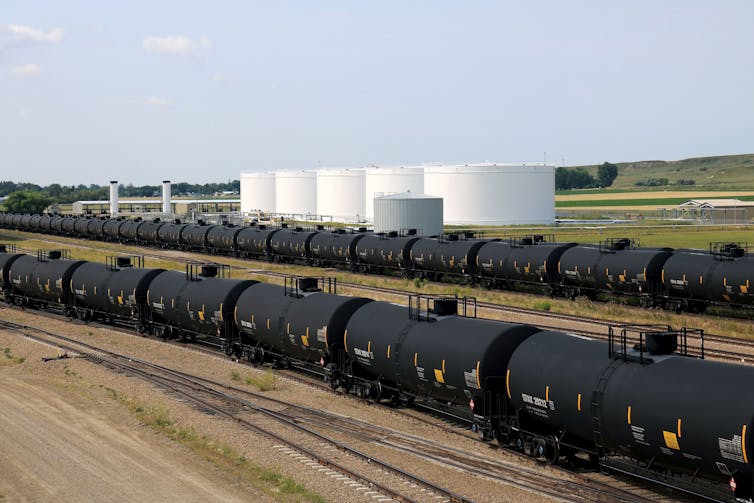Supreme Court could narrow the scope of federal environmental reviews, with less consideration of how projects would contribute to climate change
Environment + Energy – The Conversation Read More [[{“value”:”
In the 1993 movie “Jurassic Park,” Dr. Ian Malcolm, a fictional math genius specializing in chaos theory, explains the “butterfly effect,” which holds that tiny actions can lead to big outcomes. “A butterfly flaps its wings in Peking,” Malcolm posits, “and you get rain in Central Park instead of sunshine.”
What about when a federal agency flaps its wings? Should bureaucrats be required to think through the extended effects of decisions like funding a highway intersection or approving an offshore wind farm?
Congress opened the door to this question in 1969 when it passed the National Environmental Policy Act, known as NEPA. This law requires federal agencies to analyze the environmental effects of major proposed actions before making decisions.
On Dec. 10, 2024, the Supreme Court will hear oral argument in Seven County Infrastructure Coalition v. Eagle County, Colorado, the first major NEPA dispute before the court in 20 years. The Supreme Court’s ruling could significantly affect how NEPA applies going forward, especially with respect to climate change.
The ‘rule of reason’ test
Under NEPA, federal agencies considering major actions must prepare an environmental impact statement – a detailed analysis of the “reasonably foreseeable environmental effects” of the proposed activity. The Council on Environmental Quality, a White House office that advises the president, has adopted rules that divide potential outcomes into three categories:
-
Direct effects, such as cutting down trees to build a highway;
-
Indirect effects that occur later in time or farther away, such as development spurred by building the highway; and
-
Cumulative effects of the action when added to the effects of other past, present and reasonably foreseeable actions, such as building multiple highways in a region.
The Supreme Court last addressed NEPA when it unanimously ruled in 2004 that an agency only needs to consider effects that have a “reasonably close causal relationship” with the proposed action. The court also explained that where an agency lacks legal authority to prevent a certain effect, the agency cannot be considered legally to have caused that effect.
Together, these limitations are known as the NEPA “rule of reason” standard. The tricky issue has been defining how far out in time, location and causation an agency should project when it analyzes potential effects.
Only a small percentage of federal actions require an environmental impact statement, but those reviews can consume years in the timeline for approving major projects. Defining how broad they need to be is, thus, a critical question for industries such as transportation and energy production.
A rail line in Utah
The Eagle County case stems from a proposal by a coalition of railway project developers to build an 85-mile rail line in Utah to transport waxy crude oil from wells to the interstate rail network. The developers sought a license from the Surface Transportation Board, an independent federal agency, which prepared an environmental impact statement and ultimately approved the license in 2021.
Officials in Eagle County, Colorado, sued, along with several environmental groups, arguing that the environmental impact statement was defective. In their view, the Surface Transportation Board should have gone further in considering “upstream” environmental effects that the railway would induce, such as increased oil drilling, and “downstream” effects of refining and consuming that additional oil.
This upstream/downstream effects question has been a hot NEPA topic over the past decade, mostly in connection with greenhouse gas emissions induced by oil and natural gas pipelines. In 2023, the Council on Environmental Quality issued guidelines addressing the question. Lower federal courts have grappled with it as well. Agency practice and judicial decisions since 2004 align more closely with a broad analysis approach, although the lines aren’t clearly drawn.
Arguing before the U.S. Court of Appeals for the District of Columbia Circuit, lawyers for the Surface Transportation Board asserted that the agency didn’t have enough information to analyze in detail where oil development might increase as a result of building the rail line, or how that oil might be used. But the court found that the agency had failed to adequately explain why it could not employ “some degree of forecasting” to identify those impacts.
The board also had decided that it was not required to consider effects of increased oil production and refining, because it had no authority or jurisdiction over those activities. The D.C. Circuit rejected that argument, asserting that the agency could prevent those effects by exercising its authority to deny the license.
What should agencies have to consider?
Now, the Seven County Coalition is asking the Supreme Court to resolve whether NEPA requires an agency to study environmental impacts “beyond the proximate effects of the action” that the agency regulates.
This question unpacks two themes that define how agencies should analyze projects’ indirect effects. First, to what extent does tort law – the body of law that addresses wrongful actions one person causes to another person – guide application of NEPA?
Under tort law, a person claiming that someone else wrongly injured them must show that the accused could have reasonably foreseen the harm, and that their action was its proximate cause. To date, courts have expected agencies to consider the effects of their actions more broadly under NEPA, since a federal agency decision can affect many people and NEPA is intended to inform the public about the proposed action, not to resolve injury claims.
Making the tort law approach standard for NEPA reviews, as the Seven County Coalition advocates, would allow agencies to limit consideration of indirect effects.
The second question addresses the scope of agency authority. The Seven County Coalition argues that NEPA does not require regulators to study indirect effects outside the agency’s direct control under their permitting authority. The coalition asserts that the D.C. Circuit’s broad-scope reading of the rule of reason risks saddling the Surface Transportation Board with “endless make-work far outside its wheelhouse.”
Other interest groups, such as the U.S. Chamber of Commerce, say the broad-scope version gives agencies effective power to regulate far beyond their delegated permitting authority.

Education Images/Universal Images Group via Getty Images
Conversely, Eagle County and the environmental groups argue that the board has the power to deny the rail line a license because of its indirect effects, so the agency should be required to consider those effects in its review. And in an amicus brief, the Howard University Law School Clinic argues that NEPA’s broad indirect effects scope has proved to be a “vital civil rights tool that empowers those who have historically been excluded from decision making processes.”
Concerns like these have led former federal officials and Council on Environmental Quality leaders from Republican and Democratic administrations to line up behind the rail line opponents. Members of Congress have also filed amicus briefs, with Democrats supporting the rail line opponents and Republicans supporting the developers.
Climate change and NEPA reviews
If the court supports the rail developers’ position on either of these two major questions, I believe 20 years of NEPA practice and case law under the rule of reason test will be nullified, and a new era of NEPA litigation will begin.
Many pro-NEPA observers are worried about this possibility for one very important policy realm in particular: climate change.
If the court were to move the foreseeability standard for NEPA reviews closer to tort law doctrine, it would provide agencies cover for doing little in their environmental impact statements to explore how proposed actions could contribute to climate change, beyond quantifying their direct greenhouse gas emissions.
More bluntly, if the court rules that agencies don’t have to consider indirect effects that are out of their direct regulatory control, most agencies could simply ignore indirect climate change impacts, since they have no direct control over sources of greenhouse gas emissions.
Although the Supreme Court hasn’t addressed NEPA directly since 2004, many of its recent rulings seem designed to reduce the power of regulatory agencies. In my view, NEPA isn’t likely to fare well under that agenda.
“}]]
